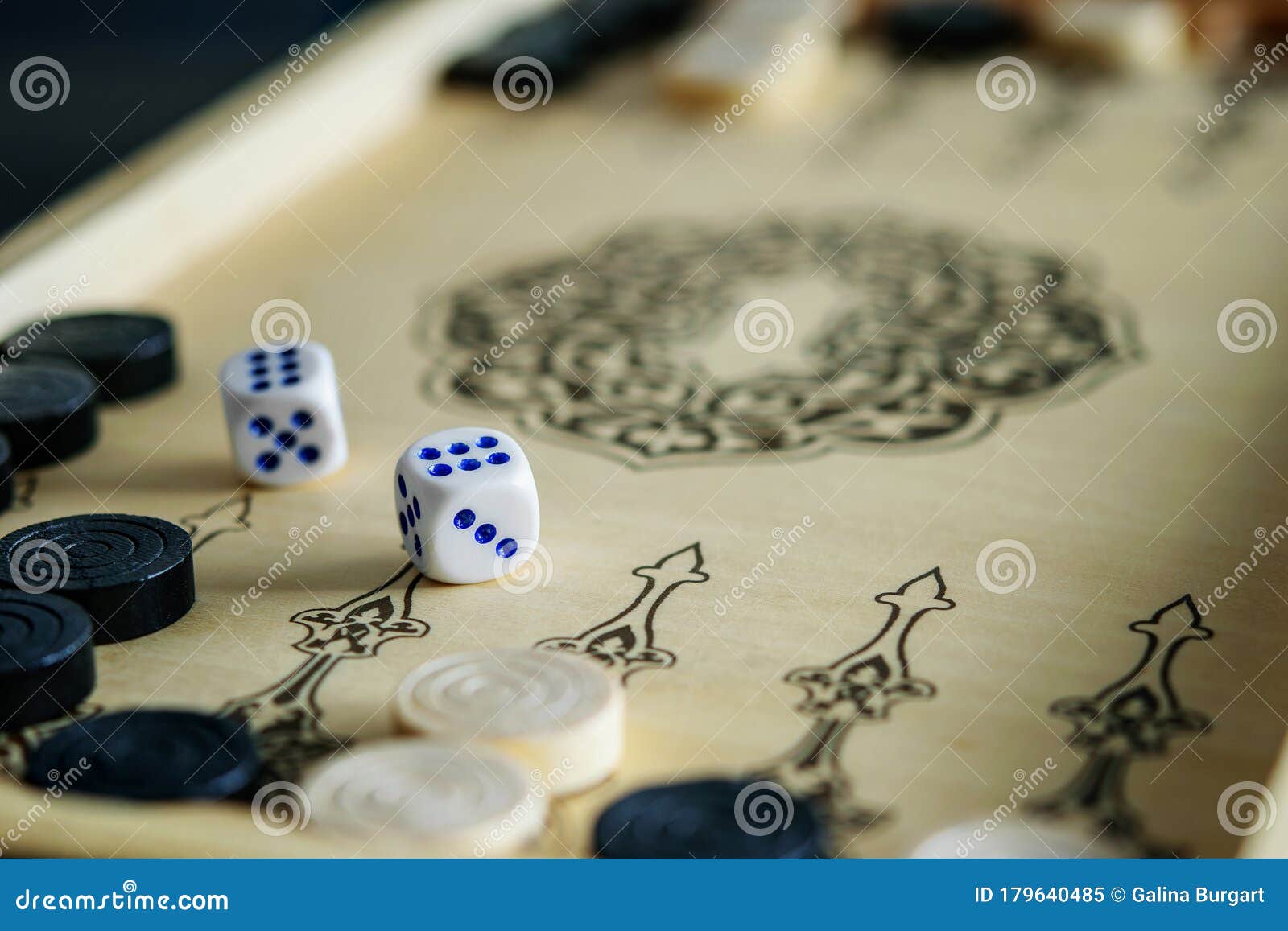Gambling Dice Backgammon
Backgammon is one of the most ancient gambling games of all. Historians don’t know the exact origin date of the game, but backgammon boards as old as 3000 BC have been found—making the game almost 5000 years old. The Ancient Greeks and Romans both played backgammon for fun (and presumably for real money, too.)
Backgammon is now a popular gambling game, but it’s not something you see in many casinos. People tend to gamble on backgammon at home and in bars. It’s like dominoes in that respect. It’s also popular among poker players of a certain age, and it’s recently started growing in popularity online as a real money gambling game.
Like poker, backgammon combines skill and chance. You can get lucky and win against a better player some of the time, but in the long run, just like in Texas holdem, the better player always walks away with the money eventually.

While this would be the case when playing backgammon in real life, in a more casual setting, casino backgammon is slightly different, as, in this (seldom-seen) game, players wager on whether pieces will jump the center bar and make it out the half-sized board in a certain number of dice rolls. The betting rules for backgammon – online or in a. Professional backgammon dice and game backgammon dice in a variety of sizes and colors. Wooden doubling cubes in 5/8 inch (18mm) and doubling cubes in 22mm, 30mm and 36mm. Products 1-2 of 2.
Luckily, backgammon is also easy to learn and easy to play. Understanding the strategy behind the math of the game is more complicated, but if you’re used to probability math, it shouldn’t give you too much trouble. This post is meant to provide you with an easily-understood introduction to how to play backgammon.
What Kind of Equipment Do You Need to Play Backgammon?
Of course, if you’re playing on a computer, the only equipment you really need is a decent computer and an internet connection. But understanding the game itself requires understanding the physical components the game is traditionally played with.
Most people just buy a backgammon set. They’re not expensive. You can get one on Amazon for $20, but you can spend more on it if you like. My suggestion is that you start with a cheap set before upgrading to an expensive set. If you hate the game, you’re only out $20. But if you decide you love it, you can and should upgrade to a quality set. Playing games with nice equipment is always better.
Here are the pieces that come with a backgammon set:
- The board – Backgammon is a board game, so it’s played on a board. It could be any size or color. Regardless of size or color, a backgammon board always has 24 triangles and a bar separating the 2 halves of the board.
- Checkers – These are similar to the checkers you’d find with a checkerboard, but they’re often called “men” when playing backgammon. Basically, they’re just disks. They can be made of plastic or wood or anything else the manufacturer likes. A complete set comes with 30 men. Half of them are one color, and half of them are another. Black and white are common, but you can find sets with different colors.
- Dice – A good backgammon set will include 2 sets of dice and 2 cups to use. When you roll the die using the dice cups, you’re likelier to get a truly random result. These are six-sided dice, similar to what you would use to play Monopoly or craps.
- The doubling cube – This is a cube specific to backgammon. It’s a cube with the following numbers printed on it: 2, 4, 8, 16, 32, 64. (Since it has 6 sides, it’s similar to a die, but the numbers are different and important. It also serves a much different purpose than the dice.)
That’s really all you need to play.
Setting Up the Board
Backgammon is usually played as a 2 –player game (although there is a 3-player version which I won’t cover in this post.) The black players sits across from the white player, and the men are placed on the triangles. On the white side of the board, 5 black men are placed on the left-most triangle nearest the white player, and 5 white men are placed on the triangle corresponding to it on the other side.
The left-most triangle immediately to the right of the bar has 5 white men placed on it, and 5 black men are on the opposite side. Then on the right-most triangle, you have 2 black men on the white player’s side, and 2 white men on the black player’s side. The starting board looks like this:
The triangles are called “points.” (There are 24 of them; 12 on each side.) “The bar” is the spot in the middle that bisects the board. The 2 sides of the board are called “boards.” Each board has 6 points, and the bar is considered the 7th point.
White’s “home board” is the board to his left. Black’s “home board” is the board to his right. Both players home boards are on the same side of the board. The white player moves his men toward his home board. The black player moves his men toward his home board, too. White moves his men counter-clockwise, while black moves his men clockwise.

Your Goal in Backgammon
Your goal is to get all your men into your home board by moving them forward. Once all your men are on your home board, your goal is to “bear off” your men. That means to remove them from the board. The 1st player to bear off all his men wins.
You can only move your men in one direction, and as I pointed out already, you move your men in the opposite direction from the direction your opponent moves his men. The outcomes of your dice rolls determine how you move your men.
Backgammon Game-Play

Each player starts by rolling a single die onto the board on his right. If you get a higher number than your opponent, you go first. Otherwise, he goes first. That roll is also treated as the first roll of the game. You use the total of the die you rolled with the die your opponent rolled to determine how far to move your man.
For example, if you roll a 6, and your opponent rolls a 1, you go first. You get to move your men in a combination of 7 spaces. If you both roll the same number, you both re-roll until you get 2 different numbers. No one moves or plays until this initial roll is resolved. Players alternate rolling the dice from the cup and moving their men accordingly. You always roll the dice from the cup into the board on your right. As long as the dice are still on the board, your turn isn’t final, but once the dice are picked up, your move is over.
When you roll the dice and move, you have the following options:
- You can move one man the total of the 2 dice, but you must move him in 2 separate moves. (In the example above, you could move one of your men 7 points, but you have to move him 6 points then 1 point.)
- You can move one man the number on one die and another man the number on the other die. (In the example above, you can move one man 1 point and the other man 6 points. You can do this in either order, moving one man 6 and another man 1 or moving one man 1 and another man 6.)
There’s an exception to these rules, too, though: If you roll doubles—the same number on each die—you can move twice these numbers. For example, if you roll a 3 and a 3, you get to move 12 total spaces, as follows:
- You can move one man 4 times, 3 points each time.
- You can move one man 3 times, 3 points each time, and another man once, 3 points.
- You can move one man twice, 3 points each, and another man twice, also 3 points each.
- You can move one man twice, 3 points each, another man once, 3 points, and a 3rd man once, 3 points.
- You can move 4 men 3 points each.
Also, if you roll the dice and if they don’t land flat on the board—if they’re leaning against a checker, for example, you must re-roll both dice.
But there’s another rule regarding moving your men. They can only land on one of the following points:

- A point where your men sit.
- A point where no man sits.
- A point where your opponent has a single man (a “blot”).
If an opponent’s point has 2 men on it, that’s a “made point.” You can’t land on it. When you’re moving, you can pass over your opponent’s points. It matters where you land, but what’s on the points between where you start and where you land don’t matter.
When you land on an opponent’s blot, you’ve “hit” that blot. You get to remove that man from the board and place it on the bar. If you have a man on the bar, you can’t move your other men until you’ve moved that man off the bar. If, because of the movement rules, you can’t move the man back onto the board, you don’t get to move at all.
Gambling Dice Backgammon Rules
Once all your men are on your home board, you can start bearing them off. You do this by rolling the dice. You don’t have to roll the exact number, but you do need to roll equal to or higher what it would take to move that man forward that many points.
Gambling Dice Backgammon Game
It’s also possible that you’ll have all your men moved to your home board, but one of your blots gets hit. If that happens, you must stop bearing off until you’re able to re-enter that man to the board. If you roll doubles, you can bear off twice as many men if you have enough movement. Also, you’re not required to bear off. You can also move points to make it easier to bear a man off on your next turn.
How to Gamble Real Money on Your Backgammon Game
You can play backgammon without gambling at all, but where’s the fun in that? I’m just kidding. I think most games improve a little when you put some money on the line, but I don’t think having dollars in action is a necessity, either. If you do want to spice things up, though, here’s how to play backgammon for real money:
The first thing you do is agree to the stakes you’re playing for with your opponent. You might agree to play the game for $1 or $10. Whatever you both agree to is fine. Whoever wins gives the other player the amount that you agreed to when you set the stakes. But you also have the opportunity to increase the stakes by using the doubling cube.
When the game starts, the doubling cube is placed with the 64 up. If at some point you or your opponent thinks you’re going to win, you can take the doubling cube and turn it to 2. You then notify your opponent that you’re doubling the stakes.
You can only double when it’s your turn to roll the dice. Until someone has doubled, either player can double at their discretion. After one player has doubled and the other player accepted, the player who accepted owns the cube and is the only one with the option to double again. You and your opponent can double and redouble as many times as you both like. There’s no upward liit of 64 based on the cube. It would be unusual for the stakes to get too high, though.
Gammons and How They Affect the Stakes
A “gammon” happens when you bear off all your men while your opponent still has all his men on the board. In the event of a gammon, the losing player pays off double stakes. If the doubling cube has been used, the losing player must pay double what the stakes are AFTER taking into account the doubling cube.
Backgammon is an ancient game that’s most often played by gamblers. It combines skill and luck in the same way poker does. Like most board games, backgammon can be played for real money or just for fun.
The rules are easy to learn, but the strategy is hard to master. It requires some significant understanding of probability and how they affect dice. Backgammon is worth learning how to play for real money, and if you use the doubling cube effectively, you can win a lot of money playing.